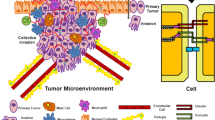Abstract
Our understanding of the essential role played by cancer stem cells or tumor-initiating cells in epithelial cell-derived tumor types is rapidly advancing. Nevertheless, the identification and characterization of these cells pose a considerable challenge. Among changes in the epithelium in oncogenesis are changes in the permeability barrier, a phenotypic trait based on tight junction formation and function. Tight junctions regulate the movement of solutes, ions and water across the paracellular space. On a cellular level, they maintain cell polarity by limiting the lateral diffusion of membrane components. Depending on the type of epithelial tissue, the barrier characteristics with respect to electrical resistance, size and ion charge selectivity vary quite significantly. Thus, elucidating changes in expression of Claudins, an essential component of tight junctions, has become a very active area of investigation in oncogenesis. This chapter provides detailed protocols on how to quantify three aspects of tight junction physiology using in vitro cell culture systems that are particularly applicable to analysis and comparison of cancer stem cells and their normal counterparts.
Similar content being viewed by others
References
Gray, R. S., Cheung, K. J., & Ewald, A. J. (2010). Cellular mechanisms regulating epithelial morphogenesis and cancer invasion. Current Opinion in Cell Biology, 22(5), 640–650.
Subbaiah, V. K., Kranjec, C., Thomas, M., & Banks, L. (2011). PDZ domains: The building blocks regulating tumorigenesis. Biochemical Journal, 439(2), 195–205.
McCaffrey, L. M., & Macara, I. G. (2011). Epithelial organization, cell polarity and tumorigenesis. Trends in Cell Biology. [Epub ahead of print] PMID: 21782440.
Creighton, C. J., Chang, J. C., & Rosen, J. M. (2010). Epithelial-mesenchymal transition (EMT) in tumor-initiating cells and its clinical implications in breast cancer. Journal of Mammary Gland Biology and Neoplasia, 15(2), 253–260.
O'Brien, C. A., Kreso, A., & Dick, J. E. (2009). Cancer stem cells in solid tumors: An overview. Seminars in Radiation Oncology, 19(2), 71–77.
Wang, J. C., & Dick, J. E. (2005). Cancer stem cells: Lessons from leukemia. Trends in Cell Biology, 15(9), 494–501.
D'Angelo, R. C., & Wicha, M. S. (2010). Stem cells in normal development and cancer. Progress in Molecular Biology and Translational Science, 95, 113–158.
Ma, I., & Allan, A. L. (2011). The role of human aldehyde dehydrogenase in normal and cancer stem cells. Stem Cell Reviews, 7(2), 292–306.
Arabzadeh, A., Troy, T. C., & Turksen, K. (2007). Changes in the distribution pattern of Claudin tight junction proteins during the progression of mouse skin tumorigenesis. BMC Cancer, 7, 196.
Turksen, K., & Troy, T. C. (2011). Junctions gone bad: Claudins and loss of the barrier in cancer. Biochimica et Biophysica Acta, 1816(1), 73–79.
Herschkowitz, J. I., Zhao, W., Zhang, M., Usary, J., Murrow, G., Edwards, D., Knezevic, J., Greene, S. B., Darr, D., Troester, M. A., Hilsenbeck, S. G., Medina, D., Perou, C. M., Rosen, J. M. (2011). Comparative oncogenomics identifies breast tumors enriched in functional tumor-initiating cells. Proceedings of the National Academy of Sciences of the United States of America. 2011 Jun 1. [Epub ahead of print].
Taube, J. H., Herschkowitz, J. I., Komurov, K., Zhou, A. Y., Gupta, S., Yang, J., Hartwell, K., Onder, T. T., Gupta, P. B., Evans, K. W., Hollier, B. G., Ram, P. T., Lander, E. S., Rosen, J. M., Weinberg, R. A., & Mani, S. A. (2010). Core epithelial-to-mesenchymal transition interactome gene-expression signature is associated with claudin-low and metaplastic breast cancer subtypes. Proceedings of the National Academy of Sciences of the United States of America, 107(35), 15449–15454.
Turksen, K. (2011). Claudins and cancer stem cells. Stem Cell Reviews. 2011 Apr 28. [Epub ahead of print]
Colegio, O. R., Van Itallie, C. M., McCrea, H. J., Rahner, C., & Anderson, J. M. (2002). Claudins create charge-selective channels in the paracellular pathway between epithelial cells. American Journal of Physiology, 283, C142–C147.
Furuse, M., Furuse, K., Sasaki, H., & Tsukita, S. (2001). Conversion of zonulae occludentes from tight to leaky strand type by introducing claudin-2 into Madin-Darby canine kidney I cells. The Journal of Cell Biology, 153, 263–272.
Nitta, T., Hata, M., Gotoh, S., Seo, Y., Sasaki, H., Hashimoto, N., Furuse, M., & Tsukita, S. (2003). Size-selective loosening of the blood–brain barrier in claudin-5-deficient mice. The Journal of Cell Biology, 161, 653–660.
Powell, D. W. (1981). Barrier function of epithelia. The American Journal of Physiology, 241, G275–G288.
Mineta, K., Yamamoto, Y., Yamazaki, Y., Tanaka, H., Tada, Y., Saito, K., Tamura, A., Igarashi, M., Endo, T., Takeuchi, K., & Tsukita, S. (2011). Predicted expansion of the claudin multigene family. FEBS Letters, 585(4), 606–612.
Elkouby-Naor, L., & Ben-Yosef, T. (2010). Functions of claudin tight junction proteins and their complex interactions in various physiological systems. International Review of Cell and Molecular Biology, 279, 1–32. Epub 2010 Jan 29.
Gupta, I. R., & Ryan, A. K. (2010). Claudins: Unlocking the code to tight junction function during embryogenesis and in disease. Clinical Genetics, 77(4), 314–325.
Van Itallie, C. M., & Anderson, J. M. (2006). Claudins and epithelial paracellular transport. Annual Review of Physiology, 68, 403–429.
Turksen, K., & Troy, T. C. (2004). Barriers built on claudins. Journal of Cell Science, 117(Pt 12), 2435–2447.
Conflict of Interest
Authors declare no conflict of interest
Author information
Authors and Affiliations
Corresponding author
Rights and permissions
About this article
Cite this article
Buchert, M., Turksen, K. & Hollande, F. Methods to Examine Tight Junction Physiology in Cancer Stem Cells: TEER, Paracellular Permeability, and Dilution Potential Measurements. Stem Cell Rev and Rep 8, 1030–1034 (2012). https://doi.org/10.1007/s12015-011-9334-7
Published:
Issue Date:
DOI: https://doi.org/10.1007/s12015-011-9334-7




